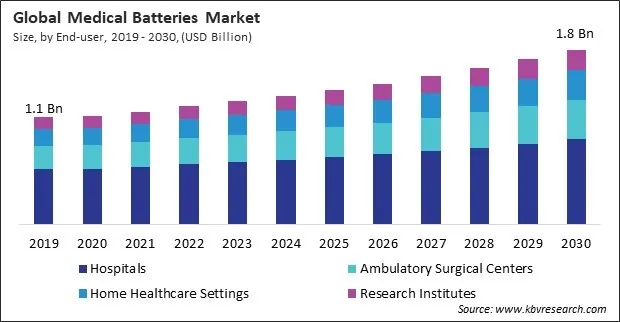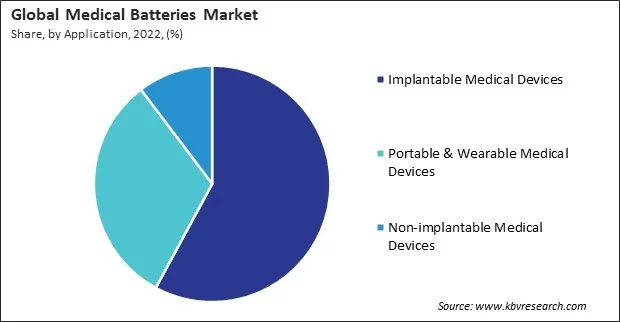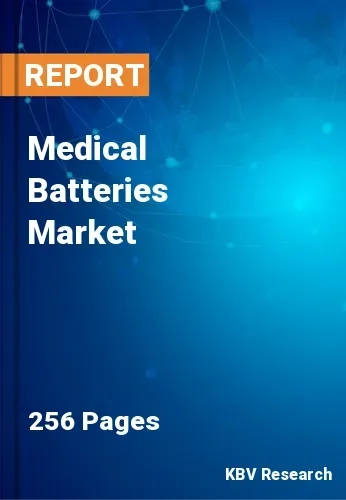“Global Medical Batteries Market to reach a market value of USD 1.8 Billion by 2030 growing at a CAGR of 5.1%”
The Global Medical Batteries Market size is expected to reach $1.8 billion by 2030, rising at a market growth of 5.1% CAGR during the forecast period.
The trend toward home healthcare is fueled by the increasing availability and adoption of medical devices designed for use in home settings. Consequently, the home healthcare settings segment would generate approximately 16.87% Share of the market by 2030. These devices include portable oxygen concentrators, continuous glucose monitors, home-use ventilators, infusion pumps, and wearable health monitoring devices. Thus, the segment will witness increased demand in the coming years.

Chronic diseases, such as diabetes, cardiovascular diseases, and respiratory disorders, are on the rise globally. Many of these conditions require continuous monitoring and management, which is facilitated by medical devices. For instance, glucose monitors for diabetes management, cardiac monitors for heart conditions, and nebulizers for respiratory conditions often rely on battery power for portability and continuous operation. The world's population is aging, and elderly individuals often require ongoing healthcare and monitoring. Thus, these aspects will boost the demand in the market. Moreover, Ongoing advancements in medical device technology involve integrating cutting-edge features, increased automation, connectivity, and miniaturization. These improvements aim to enhance the performance, precision, and efficiency of medical devices. Therefore, the market will expand rapidly in the upcoming years.
However, Hospitals operate within budget constraints, with constant pressure to manage costs efficiently. Allocating a significant portion of the budget to expensive medical devices may limit resources for other critical aspects of healthcare services. Healthcare providers often rely on reimbursements from government programs, private insurance, or other sources. The decision to invest in expensive medical devices often involves multiple layers of approval, including financial committees and stakeholders, adding complexity to the procurement process. Hence, these factors will hamper the expansion of the market.


Based on end-user, the market is divided into hospitals, home healthcare settings, ambulatory surgical centers, and research institutes. The hospitals segment recorded the maximum revenue share in the market in 2022. Hospitals are major users of various medical devices that require reliable power sources. Adopting advanced medical technologies, including diagnostic equipment, patient monitoring devices, and life-support systems, contributes to the demand for efficient and high-performance medical batteries. As a result, there will be increased demand in the segment.
On the basis of application, the market is divided into implantable medical devices, non-implantable medical devices, and portable & wearable medical devices. The implantable medical devices segment recorded the maximum revenue share in the market in 2022. The prevalence of chronic diseases, such as cardiovascular disorders, neurological conditions, and chronic pain, has been on the rise globally. Implantable medical devices are increasingly used for the management and treatment of these chronic conditions, leading to a higher demand for medical batteries to power these devices. Thus, these factors will assist in the growth of the segment.

Based on battery type, the market is segmented into lithium-ion batteries, nickel-metal hydride (NiMH) batteries, alkaline batteries, zinc-air batteries, and others. The lithium-ion batteries segment held the largest revenue share in the market in 2022. Lithium-ion batteries offer one of the highest energy densities among available battery technologies. This means they can store a significant amount of energy in a compact and lightweight form, making them ideal for medical devices where space and weight considerations are critical. Hence, these factors will boost the demand in the segment.
Free Valuable Insights: Global Medical Batteries Market size to reach USD 1.8 Billion by 2030
By region, the market is segmented into North America, Europe, Asia Pacific, and LAMEA. In 2022, the Europe segment acquired a considerable revenue share in the market. With its well-established healthcare infrastructure and a commitment to quality healthcare, Europe tends to allocate a significant portion of its budget to the healthcare sector. The growth of medical batteries is often linked to overall healthcare expenditure, as batteries are essential components for various medical devices. Hence, these aspects will help in the expansion of the segment.
| Report Attribute | Details |
|---|---|
| Market size value in 2022 | USD 1.2 Billion |
| Market size forecast in 2030 | USD 1.8 Billion |
| Base Year | 2022 |
| Historical Period | 2019 to 2021 |
| Forecast Period | 2023 to 2030 |
| Revenue Growth Rate | CAGR of 5.1% from 2023 to 2030 |
| Number of Pages | 256 |
| Number of Tables | 380 |
| Report coverage | Market Trends, Revenue Estimation and Forecast, Segmentation Analysis, Regional and Country Breakdown, Porter’s 5 Forces Analysis, Company Profiling, Companies Strategic Developments, SWOT Analysis, Winning Imperatives |
| Segments covered | Battery Type, Application, End-user, Region |
| Country scope |
|
| Companies Included | Tadiran Batteries Ltd. (Saft Groupe SAS), KAYO Battery (Shenzhen) Company Limited, Maxwell Technologies (UCAP Powers, INC.), Renata SA (The Swatch Group Ltd), Duracell U.S Operations Inc. (Berkshire Hathaway Inc.), Ultralife Corporation., EaglePicher Technologies, Panasonic Holdings Corporation, EnerSys, GE HealthCare Technologies, Inc. |
By End-user
By Application
By Battery Type
By Geography
This Market size is expected to reach $1.8 billion by 2030.
Growing demand for medical devices are driving the Market in coming years, however, Cost constraints associated with medical batteries restraints the growth of the Market.
Tadiran Batteries Ltd. (Saft Groupe SAS), KAYO Battery (Shenzhen) Company Limited, Maxwell Technologies (UCAP Powers, INC.), Renata SA (The Swatch Group Ltd), Duracell U.S Operations Inc. (Berkshire Hathaway Inc.), Ultralife Corporation., EaglePicher Technologies, Panasonic Holdings Corporation, EnerSys, GE HealthCare Technologies, Inc.
The expected CAGR of this Market is 5.1% from 2023 to 2030.
The Portable & Wearable Medical Devices segment is leading the Market by Application in 2022 there by, achieving a market value of $589.2 million by 2030.
The North America region dominated the Market by Region in 2022 there by, achieving a market value of $652.6 million by 2030, growing at a CAGR of 4.4 % during the forecast period.
Our team of dedicated experts can provide you with attractive expansion opportunities for your business.

 Drivers
Drivers
 Restraints
Restraints
 Opportunities
Opportunities
 Challenges
Challenges
